Salmon Curry with Coconut Milk
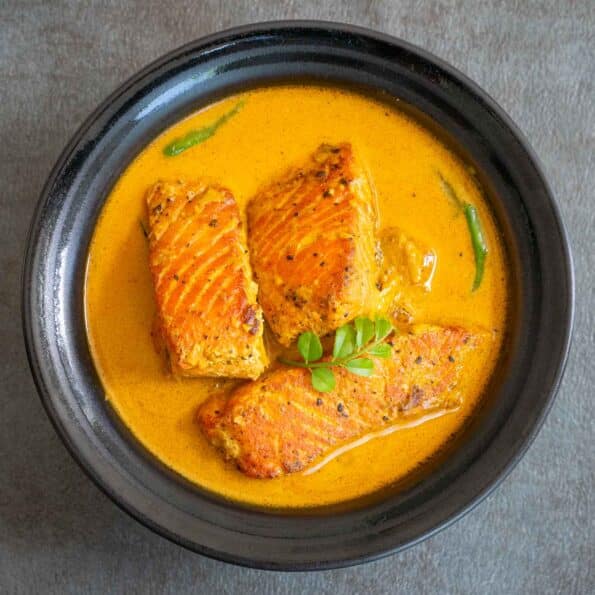
My favorite Coconut Milk Salmon Curry that I make from scratch for weeknights. It's a nice creamy comforting curry with tender flavorful salmon pieces. So simple and easy to make too. I serve it with Rice and a quick salad or a vegetable stir-fry and it's always a hit in my home. Super delicious, and healthy, and everyone loves it!
One of my childhood favorite Sri Lankan fish curry recipes inspired this Coconut milk Salmon Curry recipe. You can't easily find fresh salmon in Sri Lanka. But since it's an Island, we always get nice and fresh fish and many Sri Lankans know how to cook their fish. My mom is an amazing cook and I grew up eating so many different fish dishes. This recipe is inspired by one of her Fish curries.
This Salmon Coconut milk curry is quite similar to my other Creamy salmon curry recipe on the blog. But this one is a little more spicy, smoky, and a bit deep in flavor.
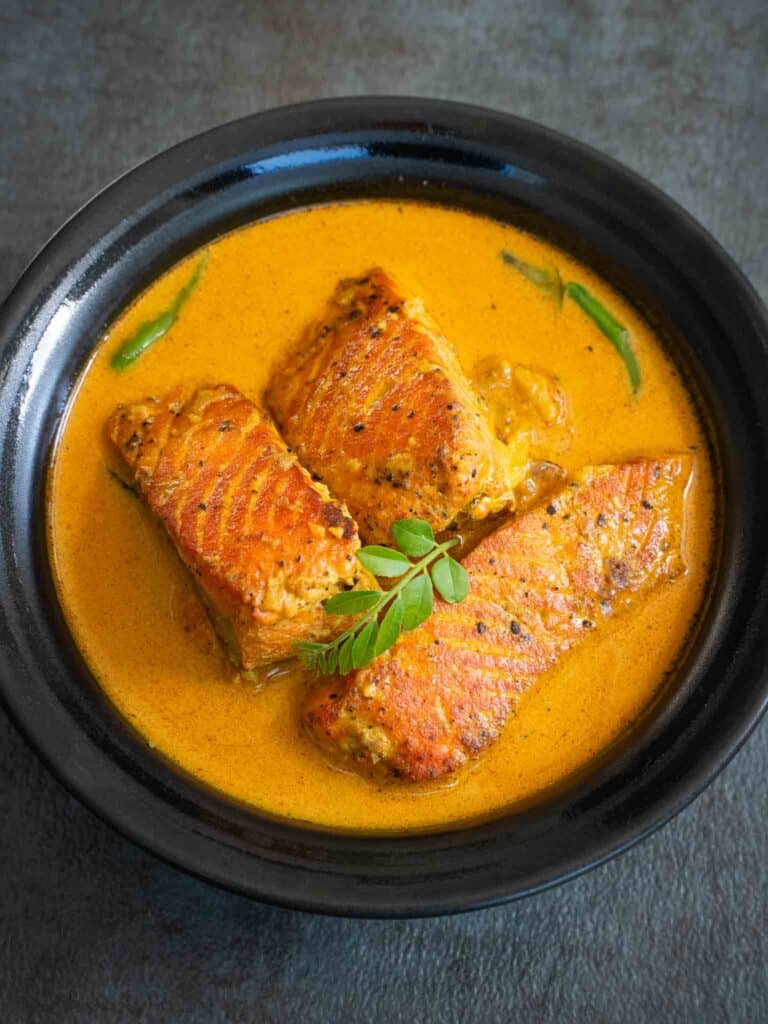
Ingredients info and substitutes:
Salmon:
I use wild-caught sockeye salmon for this recipe. It's very important that you use good quality salmon for the curry. Make sure the salmon fillet is descaled. It's very unpleasant to find fish scales in curry.
Coconut milk:
I use canned coconut milk (amazon affiliate) for this curry. Depending on the thickness of the coconut milk you use, you may have to adjust the amount of water you add to the curry. Coconut milk can boil over and sometimes coagulate with heat and acid. Cook the curry uncovered and also on medium to medium-low heat.
Cinnamon:
Use true Ceylon cinnamon as it has a much milder and sweeter flavor than Cassia (this is what most US grocery stores sell as cinnamon nowadays. If you can’t find Ceylon cinnamon use about ¾ inch piece of cassia. It’s very strong so don’t add too much.
Curry leaves and Pandan leaves:
The two most popular herbs in Sri Lankan cooking. Curry leaves are available in most Indian grocery stores. You can find fresh curry leaves on Amazon as well (affiliate link).
Pandan leaves are usually available in Asian stores. Check the freezer aisle too.
If you can’t find these two ingredients, use two bay leaves as a substitute. Bay leaves have a different flavor profile but they work well with this curry.
Garcina Cambogia (Goraka)
A popular sour ingredient (a dried fruit) that is used mostly in Sri Lankan meat dishes such as Chicken curry, Pork Curry. This ingredient is also available in Indian grocery stores usually with the name, KudamPuli/ Malabar Tamarind. You can get Garcinia from Amazon as well (amazon affiliate).
The best substitute for Garcinia is tamarind extract. Use about two teaspoons of tamarind extract in place of Garcinia in this recipe. You can always add more tamarind or a few drops of lime juice at the end if the curry needs more tanginess.
Fenugreek Seeds:
Optional ingredient. This helps thicken the curry and is added because of its health benefits. The flavor they add to this curry is mild. So if you can’t find this ingredient, that’s okay.
Curry Powder:
The curry powder I use in this recipe is Sri Lankan unroasted curry powder. It has a mild flavor and aroma. You can use regular curry powder as a substitute. Or add 1 tsp coriander powder + ¼ tsp of cumin powder.
The rest of the ingredients, I believe, are easily available in most grocery stores. If you need more information, feel free to add a comment in the comment section at the end of the recipe.
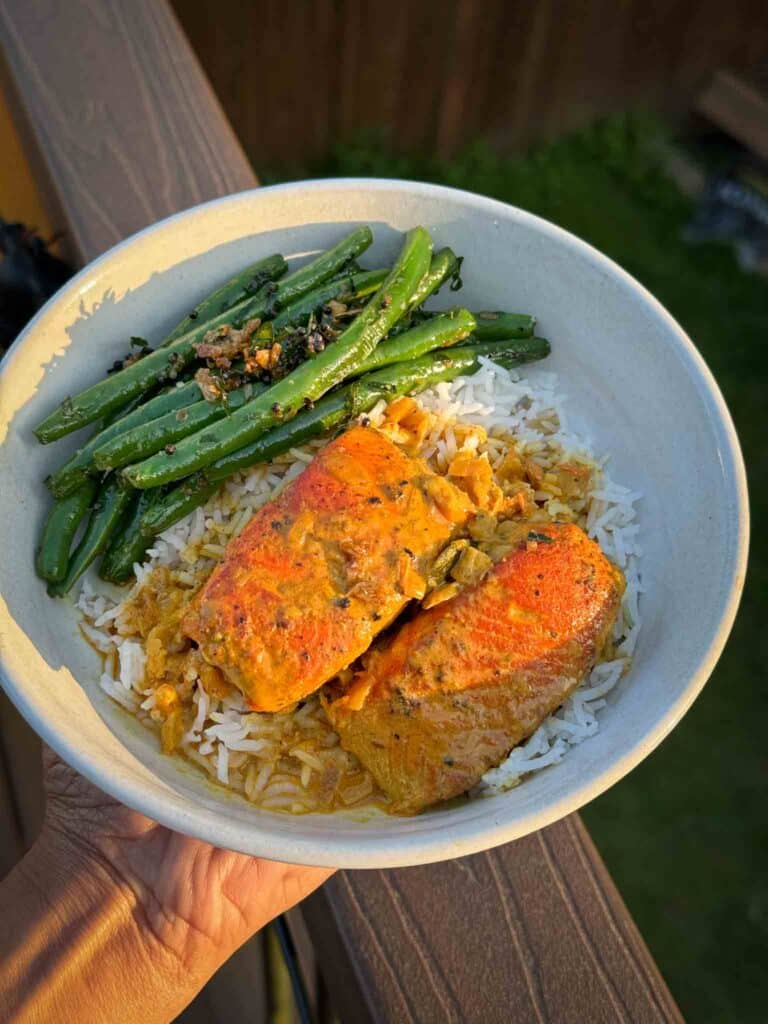
Serving Ideas for Salmon Curry:
The best way to serve this Coconut Milk Salmon Curry is with Rice and a side of vegetables. You can also serve it with Roti, Plain naan, Garlic Butter Naan and Yellow Rice.
It's a great recipe for meal prepping as well. Stores well in the refrigerator and you can easily microwave for reheating.
Recipe Video
(it might take a few seconds to appear)
Buy the products to make the curry:
(Amazon affiliate links)
I hope you give this delicious and easy Coconut milk Salmon Curry recipe a try. Don't forget to rate the recipe and let me know your feedback too. - Roshani xx
You got to try this easy healthy Salmon Curry in Coconut milk recipe. Super flavorful and perfect for a weeknight quick dinner.
- 450 g Fresh Salmon, Skin on, Cut into large 3 inch pieces or strips
- 1/2 tsp chili powder or paprika
- 1/2 tsp freshly ground black pepper
- 1/4 tsp salt
- 1 Small wedge of lime
- 2 tbsp Avocado oil or other neutral cooking oil
- 4 large cloves of garlic
- 1/2 Inch piece of ginger
- 1/8 tsp fenugreek seeds
- 2 Pieces of Ceylon cinnamon, roughly 2 inches long
- 1 large piece of goraka/garcinia (see the description for substitutes)
- 1/2 cup Onion, finely chopped
- 1 Sprig of curry leaves
- 1 Small pandan leaf broken into pieces
- 1 tsp chili powder or paprika
- 1 tsp unroasted curry powder (see the description)
- 1/4 tsp turmeric powder
- salt to your taste (start with about 1/4 of a tsp. You can adjust after tasting the curry later)
- 1/2 cup thick coconut milk (I use canned)
- 1 cup water (adjust as how thick or runny you like the curry)
- 1 lime or lemon to make zest
- 3 green chilies (optional)
- Marinate Salmon:
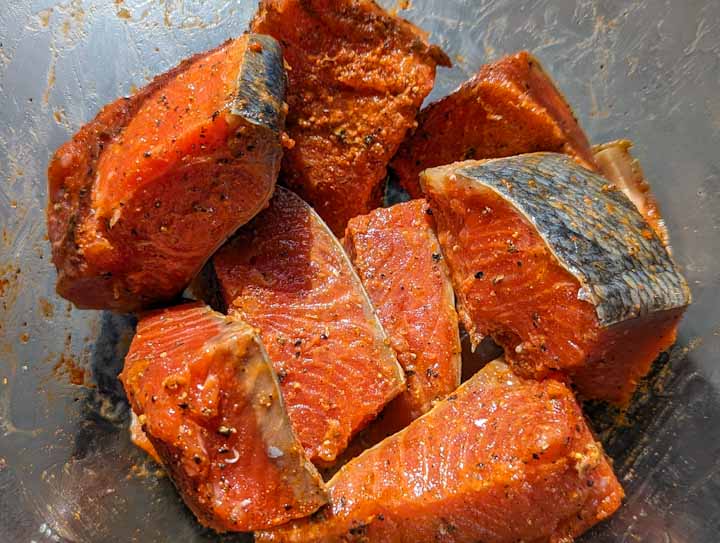
Add the marinating ingredients (chili powder, black pepper, salt and lime) to the salmon pieces. Gently rub the ingredients into the Salmon pieces to coat them. Set it aside and let it marinate for about 30 minutes.
- Prepare crushed ginger and garlic:
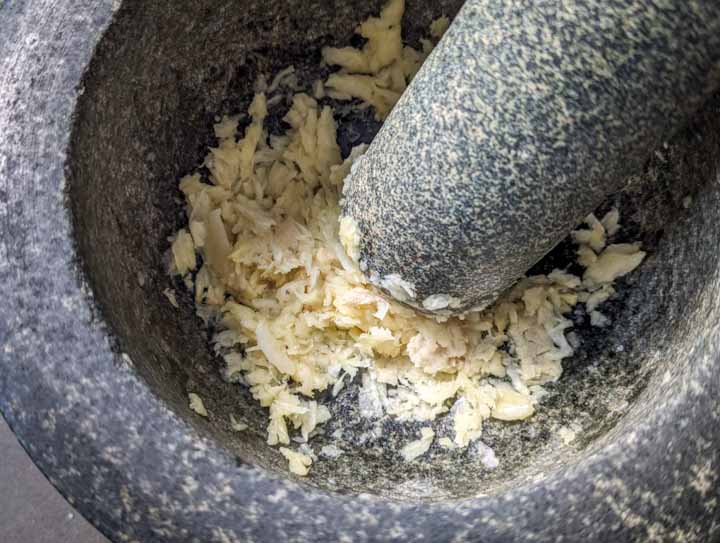
Meanwhile, Add ginger and garlic into a mortar and pestle. Pound until it becomes a rough paste. If you don't have a mortar and pestle, chop them finely.
- Sear the salmon pieces:
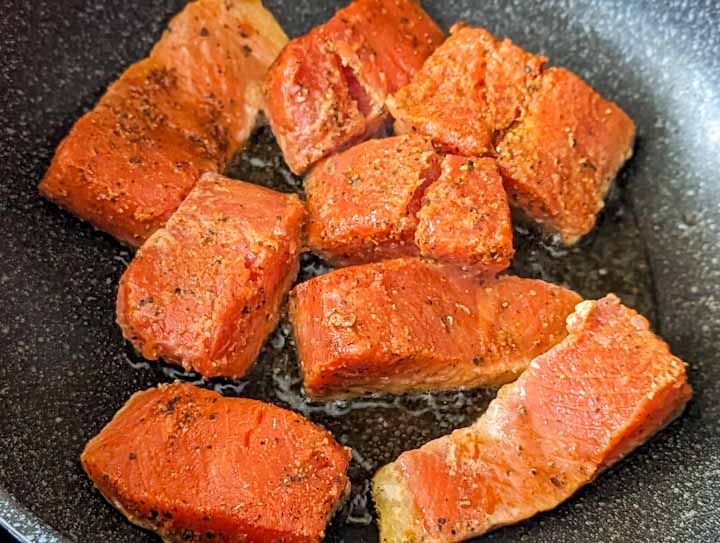
When the salmon is marinated, heat a saute pan or a flat-bottom wok. Add oil. Let the oil heat up very well. Place the salmon pieces on the pan, skin side down. Let them fry for about one minute or until the skin starts to turn golden on the edges. And then carefully flip them using tongs and sear the other side for about another minute. Salmon will still be raw in the middle. Don't worry, we are going to simmer them later in the curry.
Remove the seared salmon pieces into a clean plate and set them aside.
- Sauté the aromatics:
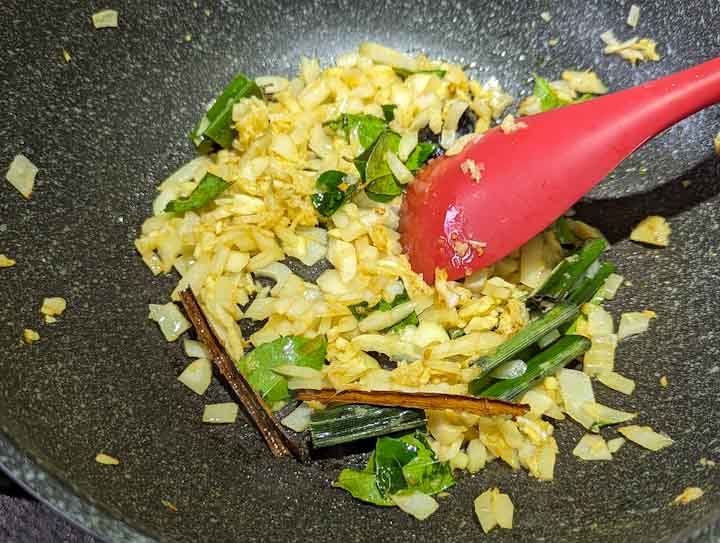
To the same pan/wok, add fenugreek seeds, Ceylon cinnamon sticks, Goraka (check the description for substitutes), crushed ginger and garlic, curry leaves, pandan leaves, and onion. Saute until onions start to soften and cook down.
- Add spices:
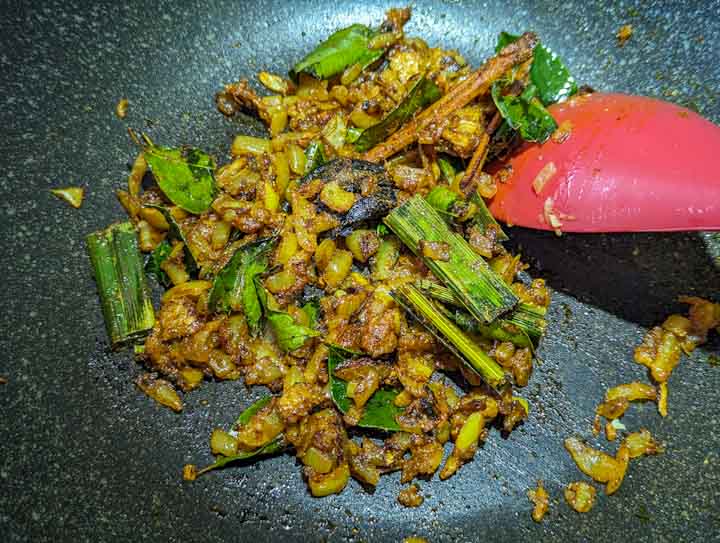
Lower the heat and add chili powder, curry powder, turmeric powder, and salt. Mix with the onions and saute for about a minute until the mixture becomes darker in color and aromatic.
- Simmer the sauce:
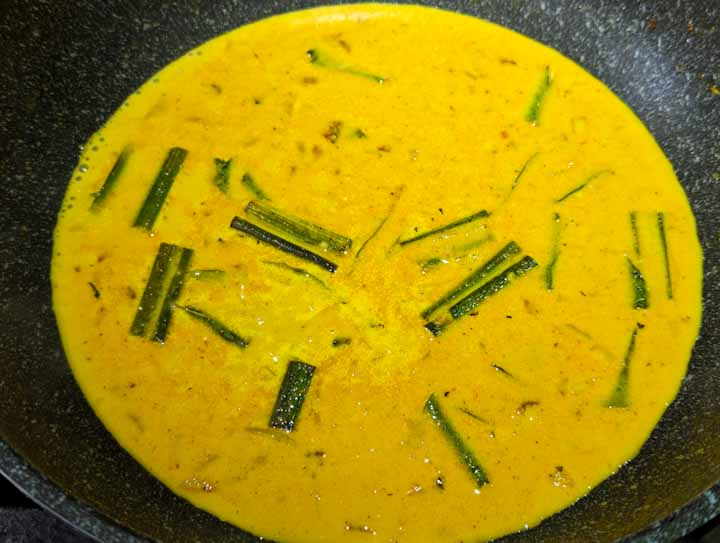
Add coconut milk and water. Stir well to combine with the spices and aromatics. Let them simmer for about 5 - 8 minutes on low heat. Stir it from time to time. Do NOT cover with a lid, as the coconut milk can boil over. (If you use freshly squeezed coconut milk, just add the water first, simmer for about 5 minutes, and then add the coconut milk and keep stirring for about a minute. fresh coconut milk tends to curdle with heat) You can add more coconut milk/water if the curry reduces too much.
- Adding Salmon:
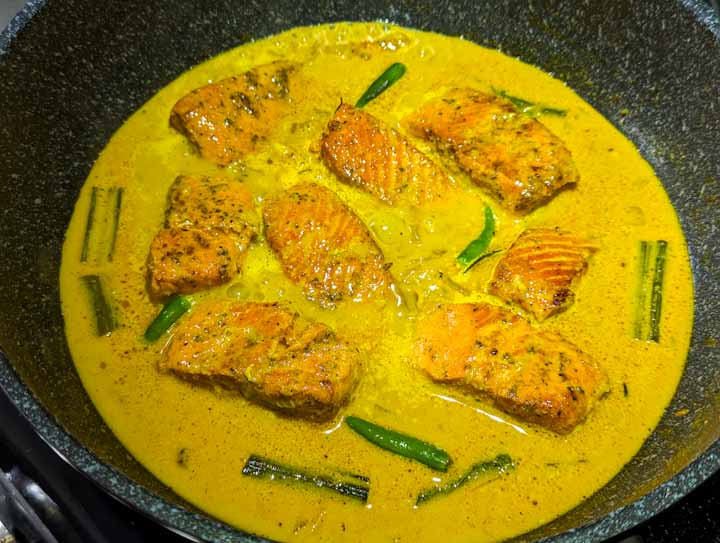
Gently place the salmon pieces in the curry, skin side down. With the help of a spoon, slowly baste the salmon pieces with the curry sauce for about 2 minutes. Please do not touch the salmon pieces too much as they can flake or break into pieces.
- Adding zest and adjusting seasoning
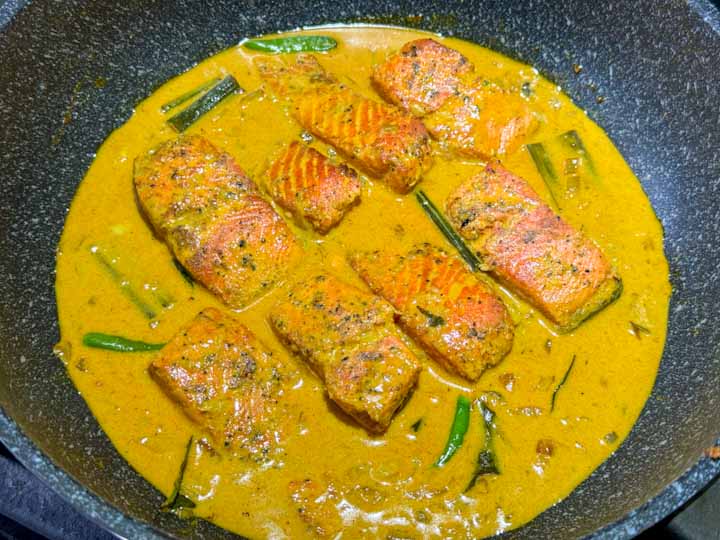
Add lemon or lime zest (I usually use 1/2 of a large lime for 1lb/450g of salmon). Also add the green chilies to the curry. Baste the salmon pieces again to mix the zest with the curry. You can gently shake and turn the pan/wok to move the sauce around. Taste the curry and adjust the seasoning. If the curry tastes bland it usually lacks salt. If the curry is not tangy enough, you can add a few drops of lime/lemon juice when the curry is done cooking (adding lime to coconut milk while it's simmering can make the milk curdle. So it's best to wait until the end to add citrus). Let the curry simmer for another few minutes in the sauce until the salmon pieces are nice and cooked all the way through and the curry has somewhat thickened.
